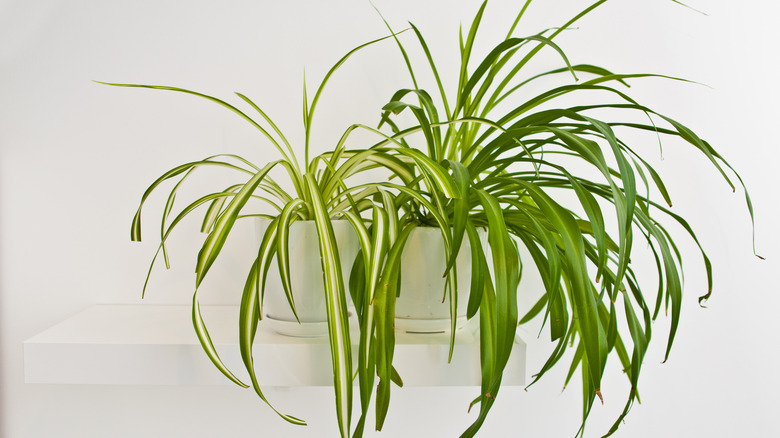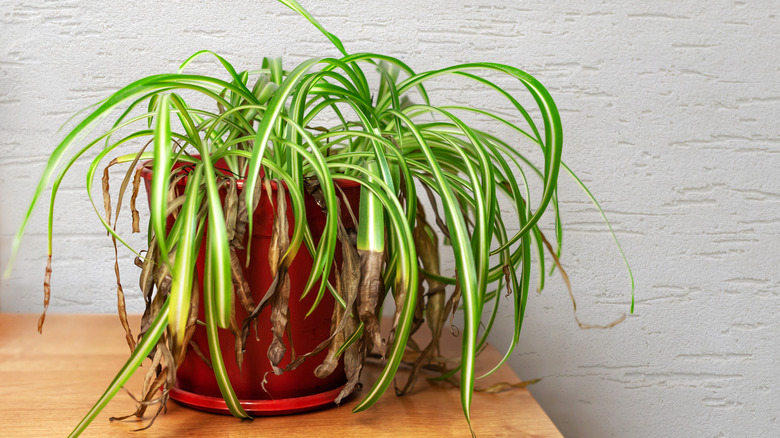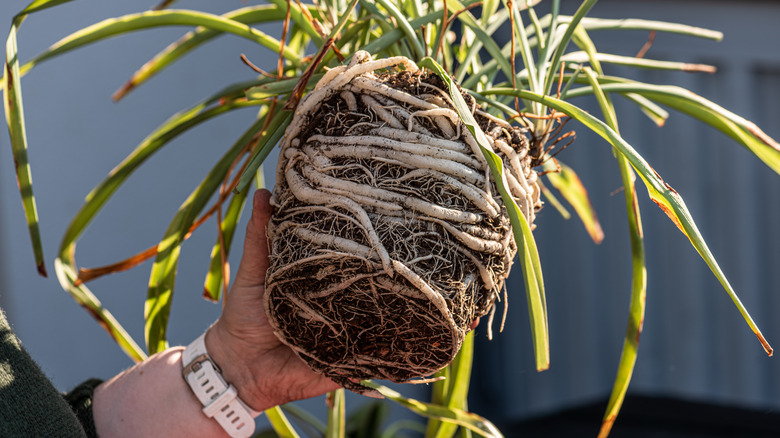What's The Best Way To Treat Root Rot On Spider Plants?
Spider plants (Chlorophytum comosum) are a species of great houseplants that are known to be easy to grow, tolerant of neglect, and adaptable to many conditions. They are native to the south African coast, as explained by the University of Wisconsin-Madison, so they are used to warm temperatures and consistent sunlight. Truthfully, these are the only two things the spider plant needs besides some water.
In general, this Chlorophytum species has very few problems. Besides a few minor pests and some leaf tip yellowing from too much fertilization, the spider plant should quickly grow with minimal intervention. However, because it is so self-sufficient and tolerant of drought, as well as dry soil, too much attention can cause it stress. As is the case with most drought-tolerant plants, root rot caused by overwatering, poor soil drainage, and/or infested soil are among the most common diseases a spider plant can develop. Though this problem is not unusual, it frequently kills plants that are over-loved or improperly grown. To avoid root rot, you should know how it appears and how to address the issues it causes.
How to tell if your spider plant has root rot
Plants develop root rot by being exposed to one or more types of fungi, including Rhizoctonia, Botrytis, Pythium, Alternaria, Sclerotinia, and Phytophthora, according to the Clemson Cooperative Extension. Once the spider plant contracts the disease from these fungi, the symptoms of root rot will likely appear rapidly. These indicators may be something as simple as foliage wilt, or you might see a dark ring around the base of the plant that comes from the infected root system.
When you recognize root rot symptoms on your houseplant, you can remove it from its container and carefully knock away soil to reveal the roots. If a spider plant is infected, some of the roots will be brown or black and mushy, as said by the University of Wisconsin-Madison. They might also have a rotten odor. Depending on how badly the cultivar is affected by root rot, it may or may not be able to be saved.
How to get rid of root rot
When home gardeners find root rot on their spider plant, most often, they decide to throw it out and start new. However, if yours has a lot of sentimental value or you simply don't want to surrender it to the trash, it is possible to save it from death with some careful attention.
To treat root rot on your spider plant, you'll want to take it out of its container and clean its roots under water in the sink. At this point, use sterile scissors to remove all of the dark and infected roots, leaving only the healthy and white root system intact, as advised by Pennington. Afterward, repot your spider plant in a new container. Your plant mustn't be repotted into its old pot where fungi spores may be lingering. The previous container will need to be sterilized with a water and bleach solution.
During the repotting process, be certain that the new pot has adequate drainage and well-draining potting soil. You may amend the soil with peat or another similar organic material that increases drainage. To avoid problems such as this in the future, only water your spider plant when its soil is about 50% dry. Spider plants thrive when neglected, and as the University of Florida points out, too of dry soil is much less likely to cause issues compared to soil that is too wet.


